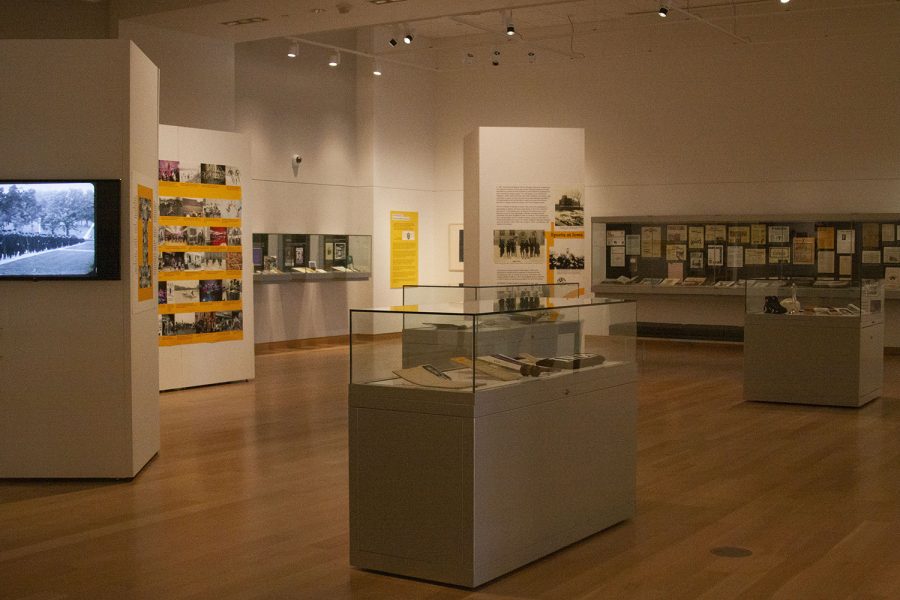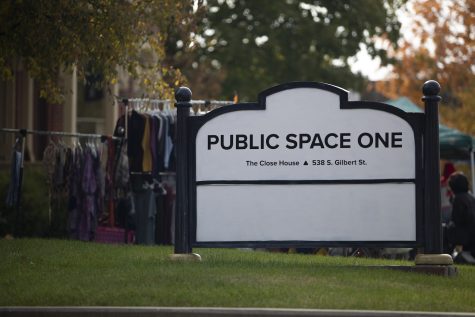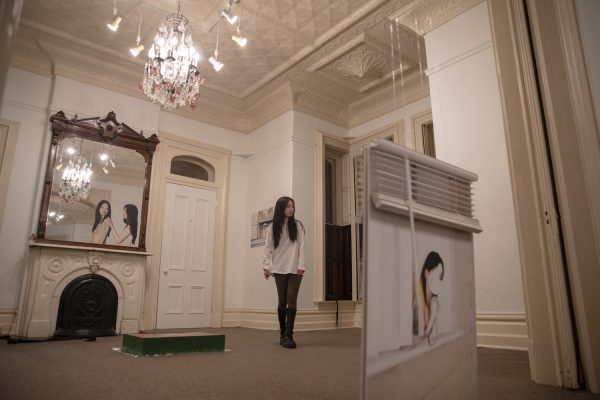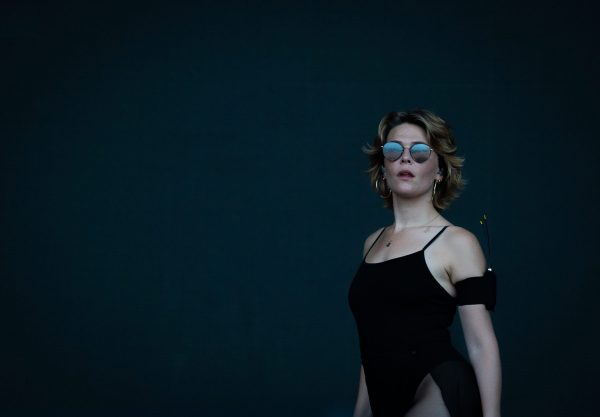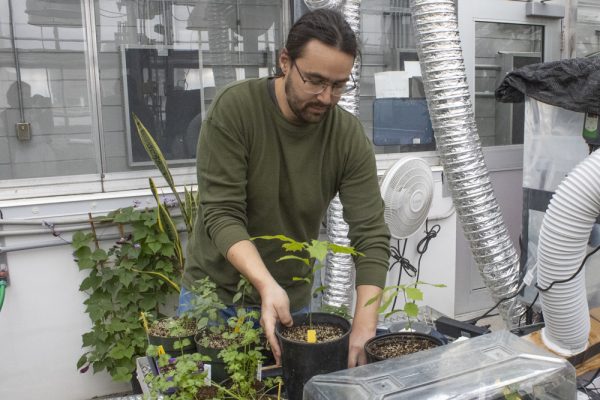Main Library exhibit displays 175 years of UI history
Held in the University of Iowa Main Library Gallery, ‘We Are Hawkeyes: Celebrating 175 Years of Student Life at the University of Iowa’ explores what’s at the center of the UI — student life.
The University of Iowa celebrates 175 years of student life with an exhibit seen in the Main Library in Iowa City on Feb. 18, 2022. The exhibit is titled “We Are Hawkeyes: Celebrating 175 Years of Student Life at the University of Iowa” and can be 9 a.m. to 6 p.m. during the week and 1 p.m. to 5 p.m. during the weekend.
February 22, 2022
Whether it be marching to the Pentacrest to protest the bombing of the Chinese Embassy in Yugoslavia in 1999, or storming Duke Slater Field at Kinnick after the Iowa vs. Penn State football game last fall – the vastness of student life has always been the heart of the University of Iowa. Now, this vastness has been documented inside the exhibit walls of the Main Library Gallery.
When it came to the university’s 175th anniversary, archivists for the UI libraries knew they needed to do something special. For Aiden Bettine, the community and student life archivist within the University Archives, the exhibit couldn’t just be a narrative of events and how they happened — it needed a central theme.
Focusing on student life throughout history at the UI was the obvious decision, and so We Are Hawkeyes: Celebrating 175 Years of Student Life at the University of Iowa was born. The exhibit opened in the Main Library Gallery on Jan. 18, and will remain open through July 3.
“If you answer the question of ‘Why does the university exist?’ – it’s to create a space and provide education to students,” Bettine said. “The thing that we should be celebrating most for this 175th anniversary is the thousands upon thousands of students who have stepped foot on this campus and impacted the history of this institution.”
The exhibit is divided into several general categories focusing on specific areas of interest, ranging from “Our Voices in Print” and “Raising Our Voices” to the basics like music and scholarship.
It was important to Special Collections Archivist David McCartney that the different sections represent the different ways that students live their college experience.
“Everyone has their own experience in college, and we bring that individual experience with us throughout our lives after we leave college,” McCartney said.
Beginning in a counterclockwise rotation around the exhibit, the “Our Voices in Print” glass display case is the first item that visitors will encounter.
Over the University of Iowa’s 175 years, there have been many student publications that have come and gone. On display are both newspapers, like an October 2021 issue of The Daily Iowan, which celebrated its 150th anniversary in 2018, and humor-oriented magazines, like the popular Frivol parody magazine that began in the 1920s and ran for at least 30 years.
Another focus of the exhibit revolves around the Iowa Memorial Union, which has served as the central hub for student life since its construction in 1926. The IMU was built with the intent of honoring people who were affiliated with the university who served in the Great War, but now also represents those who served in World War II, Vietnam, and other conflicts.
Hanging on the wall in the southwest corner of the exhibit are the blueprints for the building, and a black and white photo of students working at the old soda fountain that used to occupy part of the IMU’s space in the 1940s.
Activities like dance and music are further examples of what students can partake in while attending the UI. According to McCartney, out of all the schools in the Big 10, the UI is regarded historically as the campus to go to for the performing arts and Liberal Arts.
The exhibit includes items like a program from a Glee Concert in 1905, and a card from the Mary Ingham Dance Card Collection from the 1920s-30s, which were given as souvenirs to those who attended dances.
“We want to recognize that whether you’re a major in dance or in the school of music or not, there are students who participate just because they enjoy it or want to find a way of expression,” McCartney said.
Related: Dostoevsky at 200: Mortal Man, Immortal Lessons
The center of the exhibit houses a large display wall with photographs of students participating in events across campus.
What could be considered a mundane picture of students studying in the UI’s Main Library in 1951 is fascinating to compare to a modern-day version of the same — making current students wonder if, in another 75 years, they too could be on an exhibit wall.
In the back left corner of the exhibit are cases filled with memorabilia of Greek Life, the Scottish Highlanders — Iowa’s drum and bagpipe corps that performed from the 1930s through the 80s —, and of students who participated in military activities.
McCartney said when putting together the Greek Life case, the curators wanted to recognize that the main reason behind the creation of many fraternities and sororities was due to the restrictions on housing for Black students.
“Until 1946, they could not live in university housing,” McCartney said. “That forced Black students to live off-campus, and for many, the option was organizing a fraternity or a sorority.”
The exhibit shows a picture of a newspaper clipping from November 13, 1984 announcing the opening of Alpha Phi Alpha, at the time a new Greek organization for Black students.
Rounding the southeast corner is a striking collection of flyers and photos titled “Raising Our Voices.” Hanging on the wall beside the collection is a photo taken from a yearbook of the 1960s tradition, “Soapbox StandOff.” Every Wednesday morning around lunchtime, students would be able to stand on a soapbox and say whatever was on their minds.
In the display case is a photograph of then-student Steve Smith burning his draft card in 1965 on that same soapbox – an act that had become illegal just two months before.
“It was the first time it happened on a college campus, which I thought was significant being that it was in middle America,” McCartney said. “That opposition to the war was everywhere, not just a few elite east or west coast campuses.”
Protests play yet another important role in student life — they have been taking place since the beginning of UI history, and have continued to occur as recently as fall 2021, when students organized to protest the Phi Gamma Delta fraternity, known as FIJI, following sexual assault allegations involving multiple frat members. Whether it be on a hyperlocal or national scale, UI students have been involved in countless movements protesting for change.
“I think it shows and demonstrates the awareness, care, and knowledge that University of Iowa students have always had about what’s happening around them at multiple scales,” Bettine said. “It’s not just about what’s on campus, but they’re a part of global conversations and global protests.”
Flyers from current protests are becoming harder to collect, with information now spreading online and through social media. Luckily, the UI subscribes to a service called the Internet Archive: a system that electronically captures websites and preserves them as they appeared on that day, McCartney said.
Moving forward, a future exhibit will likely contain more digital records of protests and other events for future audiences along with tangible objects.
One of McCartney’s favorite pieces in the exhibit is a journal entry from George Ludwig, one of James Van Allen’s graduate students, depicting the morning of the first space exploration launched by the United States government, Explorer I.
Explorer I was developed and built in part by Van Allen and his graduate students in conjunction with NASA here at the University of Iowa.
“I keep thinking about what that moment must have been like for him, he was maybe 26 at the time,” McCartney said. “Eventually, he went on to a very successful career with the National Oceanic and Atmospheric Administration.”
To close out the exhibit, an assemblage of 1975 circa dorm room furniture was collected, including everything from a rust-colored floral couch to a trusty landline phone.
“I hope that people feel moved by the exhibit and find themselves connected to it, even if it’s just one item or one object in the exhibit that makes somebody feel connected,” Bettine said. “I hope the larger arc is that student history is important, and students are what make campus thrive and be this kind of incredible place.”



